As Dorea Fowler and her two daughters were nearing the end of a road trip from Atlanta to Florida, Fowler allowed her 7-year-old Boxer, Ruby, to move up and sit unrestrained in the front passenger seat of her Toyota Highlander. They were traveling uneventfully down the highway at about 65 mph, as they had for hundreds of miles, when suddenly Fowler’s SUV was struck from behind. Upon first impact, the Boxer stood up; then Fowler’s vehicle spun out of control. As the car rotated, Ruby went airborne, flew across Fowler’s lap, and hit the driver’s side window with her head. The car then hit a guard rail head on. The vehicle’s air bag and seat belts protected Fowler (and her two children), but Ruby rocketed forward into the windshield between the driver’s door and air bag. When the vehicle came to rest, Ruby was lying on her side across the front seat. The Boxer was still alive, but rigid as a board, indicating to Fowler (an RN) that Ruby had a serious head injury.
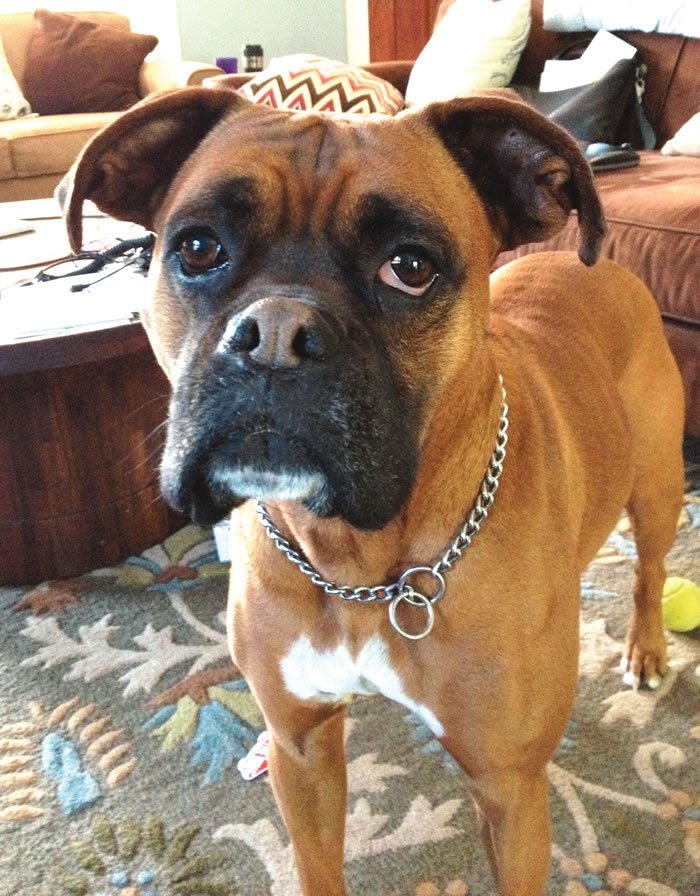
Photo by Dorea Fowler
Obviously, Fowler is not the only person to drive with her dog unrestrained in her car; more than 80 percent of American pet owners admit to playing the same sort of vehicular Russian roulette with loose dogs in their cars. So far, there are no laws that require pets to be protected with car safety restraints, though at least one state (Hawaii) has made it illegal to drive with a pet on one’s lap – more due to the danger of distracted driving than to protect the dogs.
Dogs can certainly distract their drivers in any number of ways in a car, but it’s even more common for them to be a completely innocent victim – indeed, the most vulnerable victim – in a car accident. Mandatory seat-belt laws mean that most drivers and human passengers today are belted into cars, but few dogs receive this protection. Because most of them are unrestrained, our canine companions can become deadly projectiles in an out-of-control car, injuring passengers or themselves. Frequently, they are thrown out of the car (often through a window), and in pain and panic, bolt from the scene of an accident, never to be seen again.
Injury Prevention Options
Most restraint systems, including crates, car seats, and harness/seat belt combinations, can prevent our dogs from distracting us while we’re driving. Financial considerations, convenience, the size of our dogs, as well as the size of the vehicles we already own, may dictate that a safety harness and seat belt are the best of those options for simply keeping the dog out of the driver’s way.
We’d be willing to bet, however, that all of us dog owners who are willing to use a car restraint system for our dogs expect whatever system we use to do more than simply prevent our dogs from being distractions; we also absolutely expect that they’ll keep our dogs safe in the event of an accident.
Which is why it was so upsetting to read a recent study by a nonprofit, independent pet-safety advocacy group, the Center for Pet Safety (CPS), which reported that very few of the products intended to protect our dogs in cars are capable of doing so. Most of the car safety restraints included in the CPS tests exhibited “catastrophic failures” – in other words, they either broke, or failed to secure the crash-test-dummy dogs in simulated crashes.
Accident Sparks a Passion for Safety
The CPS was founded by consultant and long-time pet safety advocate Lindsey Wolko after – what else? – an incident on the road with her English Cocker Spaniel in the car. Wolko is one of the few dog owners who regularly uses a car safety restraint on her dog. She had chosen her dog’s restraint harness carefully, after scrutinizing lots of product labels, to make sure the restraint she chose was intended to not only keep her dog from being a distraction while Wolko was driving, but also protect the dog in the case of an accident.
The harness did indeed prevent her dog from hopping around the car. But it wasn’t until Wolko had that near-miss at rush hour on a major metropolitan highway that she realized the harness didn’t perform the way she thought it would. Cut off unexpectedly by another motorist, Wolko slammed on the brakes. The jolt caused her dog to rocket off the back seat, crash against the front seat, and become entangled in the harness’s long tether. Wolko’s dog survived, but was seriously injured.
Shaken and distraught, Wolko began investigating canine car-safety restraints from the perspective of a safety expert, rather than just a consumer. She soon discovered that U.S. manufacturers are not required to crash-test pet travel products before bringing them to market. Further, she learned that there were absolutely no independent standards for any tests that companies conducted to crash-test their products; while some manufacturers claimed their products were crash-tested, this information was useless to consumers (and their dogs) in the absence of test standards.
Independent Car Safety Testing
A woman on a mission, Wolko set out to create a standard for testing pet-safety restraints. She founded CPS, dedicating the organization to companion-animal and consumer safety, and set a goal for CPS to conduct rigorous crash testing on pet-safety products using realistic crash-test-dummy dogs.
In partnership with Subaru of America, CPS engaged the services of MGA Research Corporation, an independent National Highway Traffic Safety Administration (NHTSA) contract testing laboratory, to conduct crash testing of canine car restraints. CPS developed specially weighted and designed crash-test-dummy dogs for use during testing: a 25-pound “terrier-mix,” a 45-pound “Border Collie,” and a 75-pound “Golden Retriever.”
Crash-Test Candidates
Initially, Wolko focused her attention on products whose manufacturers claimed, in advertising or product labeling, that the product had undergone “testing,” “crash testing,” or offered “crash protection.” During her research, Wolko had found that most of the manufacturers who made a claim regarding crash testing referenced the Federal Motor Vehicle Safety Standard (FMVSS) 213, “Child Restraint Systems.” This is indisputably the most rigorous standard that can and should be met by any car-safety restraint. But Wolko also discovered that many of the manufacturers who conducted crash testing tested only the “medium” size of their product, rather than the complete size range in which the product was offered. She also found that, frequently, a manufacturer’s definition of “passing” crash testing was subjective. Most importantly, Wolko’s research revealed lots of product marketing claims that were largely unfounded.
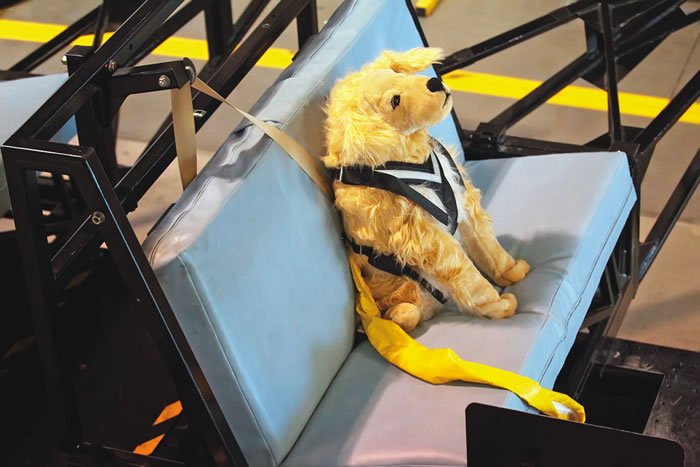
After exhaustive research of the market, Wolko found 11 brands of harnesses that met her criteria – products whose manufacturers made claims of crash testing and protection. These 11 would be the first products she tested.
Preliminary Testing
Each crash test costs about $2,000 to conduct, and the independent tests were going to be paid for by CPS and Subaru, not the manufacturers of the products. So, in order to potentially rule out any obviously inferior products prior to crash testing, CPS conducted preliminary strength testing of the harnesses.
Products purchased at retail outlets by CPS were placed on a solid dog-shaped form and pulled until the harness broke. If a particular harness withstood a five-second hold period at a specific load, then it was deemed acceptable to move on to the crash-testing phase. A failure – in any size harness – would knock that harness brand completely out of consideration for further testing.
Only seven of the 11 harness brands passed these static tests and advanced to the crash-testing phase.
Crash Testing
In general, CPS’s concept of the ideal harness would be one that, during impact, would keep a dog on the seat, control rotation of the dog (both fore and aft, as well as side to side) to help stabilize the dog’s spine, and keep adjacent passengers safe. CPS determined the following to be critical variables as to whether a harness was a “Top Performer” in these respects:
– Does the harness exhibit a catastrophic failure such that the test dog becomes a projectile or is released from the restraint? That is, does the harness break, freeing the dog to launch?
– Does the test dog stay on the seat for the entirety of the crash test? Even if the dog remains attached to the restraint, falling off the seat increases her risk of further injury.
– Does the harness have a tether that prevents adjustment to a length of six inches or less? Long tethers are dangerous, allowing the dog to launch and/or becoming wrapped around the dog’s body or limbs, leading to the risk of further injury. “Zip lines” are equally dangerous.
– Does the testing indicate uniform performance across all sizes?
The CPS used the data gathered in its tests to develop and publish its recommended standards for canine car-safety products: CPS-001-014.01, the Companion Animal Safety Harness Restraint System Standard.
At the end of the day, six of the seven harnesses included in the tests failed to meet the CPS-001-014.01 standards.
One manufacturer requested (and paid for) a re-test of its product, but only after making one change to their product’s application on the test dog dummy. The maker reversed the position of a carabiner on the harness, which improved the test result; however, it’s worth noting that the original position of the carabiner was set according to the product’s label directions. (Note: The CPS wouldn’t disclose the name of this product or manufacturer, because the manufacturer refused to sign a formal licensing agreement with CPS.)
Sole Survivor
The only product to pass the CPS tests and earn the CPS designation of “Top Performer” in the CPS 2013 Safety Harness Crashworthiness Study was the Sleepypod Clickit Utility Harness, which retails for about $90.
During testing, all three sizes of the Sleepypod Clickit Utility Harness offered by the company at the time (size XS has since been added) prevented the launch and controlled the rotation of the test-dog dummy; in addition, the dog remained on the seat after impact, and there were no equipment failures.
The Utility’s three-point connection is similar, conceptually, to the three-point seat belt required for humans by federal law. The harness is meant to be used in the rear seat (no front-seat usage!) where two side straps latch onto baby-seat anchors (which are standard equipment on all vehicles manufactured after 2003). The third connection point is via a seat belt, which is passed through the back of the harness.
Sleepypod uses a specific measurement – the total length of a figure eight around a dog’s neck and torso – to indicate which size of its product a dog should wear. The company recommends that small dogs (those who measure less than 31 inches using the measuring protocol, seen in the adjacent illustration) do not wear a harness, but are crated in a crash-tested and well-secured pet carrier instead. Very large dogs, too, are not considered good candidates for the Sleepypod Utility Harness; it’s not recommended for any dogs who measure more than 60 inches and/or weigh more than 75 pounds. (The heaviest test-dog dummy used in the CPS tests was 75 pounds, so the harness is untested at weights greater than that.)
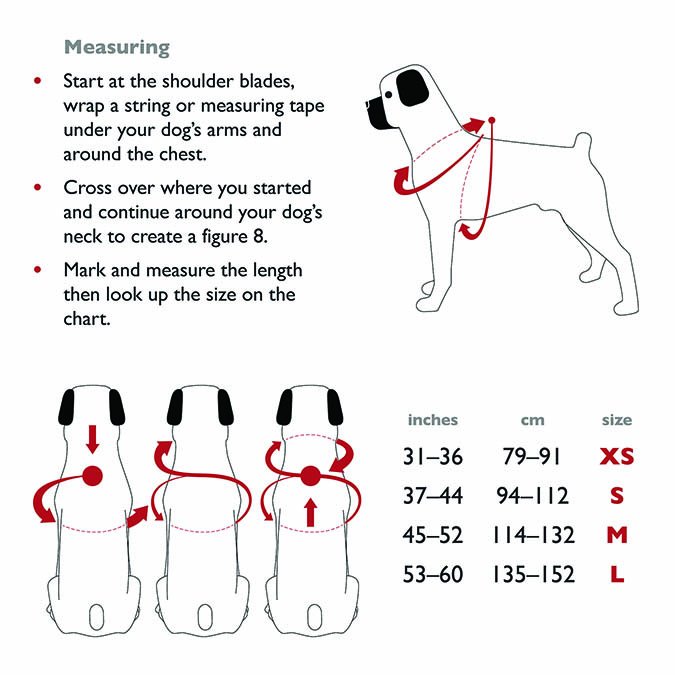
Sleepypod
Wherein We Try The Sleepypod Utility Harness
Atle, my Bouvier, is a few inches shy of the maximum measurement, and weighs in at just under 75 lbs. Getting the harness on him was pretty easy; it simply slips over the dog’s head, with two adjustable straps criss-crossing the dog’s back, and then buckles on each side.
The “vest” of the harness itself is nicely padded, and hugs the dog’s upper torso. In my opinion, it’s not too bulky or overbuilt, and surprisingly lightweight ; it can even do double duty as a walking harness.
It’s easiest to clip the two side straps to the vehicle’s anchors first, put the harness on the dog, load the dog into the car and ask him to sit, and then attach the straps to the dog’s harness. The dog’s behind should be snug against the seat when he is sitting up. The final step is to thread the car’s seat belt through the back straps of the harness and click the latch plate into the latch.
Securing Atle into my vehicle with the Utility Harness for the first few times took a little elbow grease. My first attempt at stuffing him into the back seat of my sporty station wagon left me sweaty and a bit frustrated, and he was more than a little unsure about the whole enterprise.
After a bit of struggle, and repeated out-loud readings of the instructions provided with the harness, we retired to the house for a break and for some further research online. That’s when I discovered that Sleepypod’s website features slightly better instructions for attaching the two side straps than the ones included with the harness. (It turns out that a hook on the side strap needs to pass through a D-ring on the harness, then clasp onto another smaller ring.)
For my next attempt, I loaded Atle into our van’s rear seat. First I lengthened the straps as far as they could go, and then tightened them once they were attached to the car anchors and the harness. The van seat is a little deeper than the wagon’s, and has more head room, which helped.
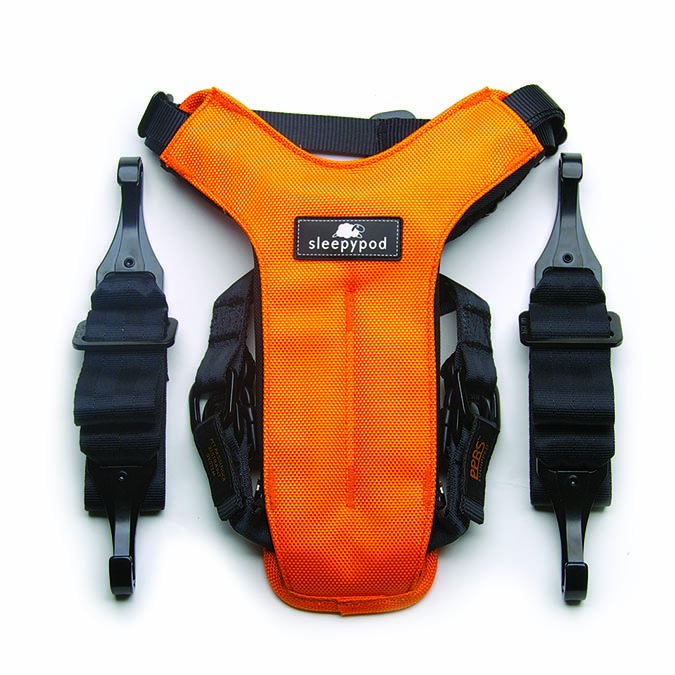
I will say that trying to maneuver a large, hairy dog into a tight space can be difficult; ideally, he needs to be in a sitting position and perfectly positioned between the car’s anchors in order to clip the side straps to the harness. Once I got Atle clipped in, he was able to move fairly easily into a down position and seemed to relax. But then I found that sitting up became the bigger challenge for him.
I don’t know how my dog would fare in this rig on a long trip, but my first impression is that the product probably would work best for dogs who were not quite as large (or hairy) as Atle. With Atle pushing the limits of the size L, he might not be the best candidate for this particular model.
Next Best Car Harnesses
Instead, we might consider a newer Sleepypod safety harness model, the Clickit Sport. This product was not yet on the market when the CPS conducted its 2013 tests, but has been tested by the CPS since, and was awarded a five-star crash-test rating. The Sport is available in three sizes and is priced at $70.
The Sport does not utilize the side straps that gave Atle and me palpitations; instead, the dog is secured only with the car’s seat belt, which is passed through the harness behind the dog’s back. Atle and I managed this easily even in the back of my station wagon.
Sleepypod’s cofounder Michael Leung commented on the differences between the company’s Sport and Utility harnesses: “The Sport was designed with ease of use in mind, and is light-weight. The frontal crash tests prove that it is as safe as the Clickit Utility.” Note that the Utility adds much more lateral control of the dog, and would add more protection for a dog in any situation beyond frontal collisions (such as side impacts).
An XL size of the Sport model (for dogs up to 90 pounds) is currently being tested by CPS and should be available by the time this article is in print.
The Rest of the Car Restraints
As I mentioned earlier, the Sleepypod Clickit Utility Harness was the only one of the seven harnesses that were included in the 2013 CPS crash tests that earned a “Top Performer” designation by CPS. One other product included in the tests exhibited catastrophic failure in both of its sizes; they broke during the crash tests. The remaining five candidates all failed in some category. Complete results can be found on the CPS website, along with some fairly disturbing video of the crash tests.
CPS invited all of the manufacturers of the products included in the tests to attend the crash tests, though only some accepted the invitation. How did the manufacturers who attended respond? “For some manufacturers, it was eye-opening and a very collaborative effort,” Wolko says. “Others didn’t appreciate our interpretation of crash protection. After the public response to the testing started to affect some of their product sales, many stopped speaking with CPS. There are several brands that applaud our efforts, and they are the ones working to consistently improve their products.”
Wolko cautions, however, that CPS recently discovered that some manufacturers are purposefully using the CPS video from testing to mislead consumers by proclaiming, “Yes, we’ve crash tested!” even if the product didn’t pass all of the CPS tests. CPS has also found manufacturers touting other connection options that were not tested but marketing the product as “safe.” It’s a classic case where buyer must be aware; don’t blindly believe the claims, but ask for substantiation. CPS hopes to run another harness test in 2015.
Hard Lesson
Remember Ruby, the Boxer mentioned at the beginning of this article? She survived her unscheduled flight around the inside of her owner’s car in the accident, but suffered a spinal-cord injury and mild brain injury. After months of intensive rehab and a $9,000 veterinary bill (paid for by the insurance company of the driver who caused the accident, who admitted to texting while driving), Fowler describes Ruby as still a “little wonky,” in that the dog still suffers from partial paralysis on her left side, and does not have full bowel control. Nonetheless, Fowler keeps her active and Ruby still loves to hike and run in the grass.
And how has car travel changed for the duo? After the accident, Fowler purchased a harness for Ruby and the dog now rides in the back of Fowler’s new SUV, secured in place. Upon learning that the harness she has been using did not pass the CPS crash tests, however, she said she’d be buying a newer one immediately. “It’s worth the money and emotional assurance to know that I’m doing all I can do to protect my dog!”




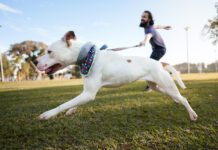


I’mafrais the article is a bit confusing. Do you not recommend the Sleepypod Clickit Sport? It seems the Utility is no longer available.
I’m afraid the article is a bit confusing. Do you not recommend the Sleepypod Clickit Sport? It seems the Utility is no longer available.
The Click-It was a great harness and saved our dog from being hurled into the front seat during a near miss! Unfortunately, Sleepypod stopped manufacturing the Click It Utility in 2015 or 2016 because customers complained that it was too hard to fit and took too long to hook up. They came out with the Sport, which doesn’t have the side tethers but those tethers were what made the harness so safe. I have an online dog store and dropped Sleepypod when the Utility went away because the Sport really is like any other auto restraint. Without those side tethers, a dog’s butt can slide forward and they can fall completely off the seat
Thank you for bringing seat belts for dogs to this much attention! What is the best seat belt for small short legged dogs? Every harness/seat belt I’ve tried, one or both legs will slip out from the harness.
What restraint is there for the back of the SUV? Mine don’t fit on seats? Is there one that would use the 3rd row seat belt coming from the ceiling?
I have 90-105 lb dogs.
I have a service dog. We often ride in cabs as I seldom drive. I’d like to have a safety harness that doesn’t require a complicated process for use.
This article is not up to date. Have any tests been run since 2013, 2015. This is 2020. In reading the comments, it looks like there isnt a harness that we can use with peace of mind for our loved pets. The one mentioned sounds like you need to be a rocket scientist to use it. Come on! Before you post an article in a current issue make sure there is substantial information that is up to date!
I would never use a harness, but have my dogs in crates that are bungied down. I have a Toyota Sienna and have removed the seats. I have 2 examples of people that were in bad accidents. One was a couple coming home from a dog show. Their dogs were in crates. The dogs survived and were barely hurt whereas the couple died. The next was an obedience trainer that was well known (Barbara Handler andhas written a book). In the first of her classes that you attend, she spends almost the entire time time talking about the importance of crating your dogs in the car. A few years after I took that class she was in an accident and lost her life. Her two Aussies survived. The crate is the “Gold Standard” for safety, and if you’re serious about optimally protecting a dog you intend to adopt, you need to have a car that can accommodate your dog, no matter the size. If your car isn’t adequate for a 175 lb dog, look for another breed. Just my opinion.
“If your car isn’t adequate for a 175 lb dog, look for another breed.” Or look for another car! ;-D Our dogs have defined our auto purchases for the last thirty-or-so years. Will the dogs fit? Nope? Move on! I know that many others aren’t as fortunate as we’ve been to be able to do that, but we’ve been very lucky. As you say, though, Randi, you definitely need to match your pups and your auto if you’re into the larger breeds.
I really believe that crating a dog when traveling is the best option – but ensuring that the crate is buckled up.
I have a 90+ pound Doodle who is as hairy as all get up. He is large enough to rest his head on the top of the back seat. I bought a Kurgo restraint, but it’s just not made for a large dog to sit up in a standard sedan.
So, here’s the problem: I really want to buy a restraint for my dog, but haven’t found any worthwhile.
I was so hoping you would have something to recommend, but alas, not.
WHY BOTHER WITH THE ARTICLE IF THERE ISN’T SOMETHING CONCLUSIVE!!!!!
I tried the sleepy pod harness on my cairns and it cut at their neck. They could barely breathe. So I returned them (not easy).
I tried a Plastic crate, but the back seat of my Subaru doesn’t have a lot of air circulation, so the dogs were panicked, without enough air. The soft crates were not recommended for car safety.
I hate to do it, but I just don’t take a dog in my car if I can help it.
I really would like to purchase a safety harness for my dog but they only go up to 90 lbs. Did you try out any that are rated for dogs over 90lbs.
The biggest problem I have is that one of my dogs has chewed through the piece that connects into the car’s seat belt female part. I crate on longer drives, but use the harness for nearby destinations.
I note the original article was published in December 2014 and updated a November 2017. Since this time there are other companies who have developed safety harnesses and have had them crash tested. Kurgo is one such product and they don’t use plastic fasteners, their harness is fully adjustable, padded and comes with strong attachment points.
My 12 yo has never accepted a crate, and I know I cannot maneuver enough to use one. I have come across Piper’s Walk regarding crash testing products.
Anyone familiar with their work? They have a Fb page…
How do I protect my 110 pound lab, too large for any of the recommended Sleepypods? I don’t know what to do.
I had to give up on the Sleepypod Utility for my younger Lab because she managed to Houdini out of it. I saw that All Safe recommended a shorter tether after the tests and that’s what I’ve been using. My car isn’t big enough for crates and I haven’t tried an SUV. I have an old house and narrow garage entrance and many vehicles won’t fit through it. I hope that more will be done to develop safer harnesses that will work for different sized dogs
Well thank you for the information it’s a lot of information thanks.